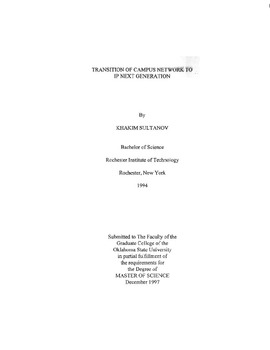| dc.contributor.author | Tanov, Khakim Sul | |
| dc.date.accessioned | 2014-09-29T19:41:28Z | |
| dc.date.available | 2014-09-29T19:41:28Z | |
| dc.date.issued | 1997-12-01 | |
| dc.identifier.uri | https://hdl.handle.net/11244/12391 | |
| dc.description.abstract | This work was conducted to define the necessity and feasibility of transition of the campus network for Oklahoma State University to IP Next Generation. IP Next Generation, or IPng, is a new protocol designed as a successor to the current version of IPv4 used in networking. Due to problems with addressing space and routing tables, IPv4 is in need of replacement. IPng comes as a solution to the problems related to IPv4. Increased addressing space from 32 to 128 bits ensures adequate space for growth of the Internet, improved design provides a potential for better performance of routers working with the Internet Protocol. It was concluded that the tunneling procedure does not impose much overhead in transition from IPv4 to IPv6. A plan of introducing IPv6 on the OSU campus was presented. | |
| dc.format | application/pdf | |
| dc.language | en_US | |
| dc.publisher | Oklahoma State University | |
| dc.rights | Copyright is held by the author who has granted the Oklahoma State University Library the non-exclusive right to share this material in its institutional repository. Contact Digital Library Services at lib-dls@okstate.edu or 405-744-9161 for the permission policy on the use, reproduction or distribution of this material. | |
| dc.title | Transition of Campus Network to IP Next Generation | |
| dc.type | text | |
| osu.filename | Thesis-1997-S954t.pdf | |
| osu.accesstype | Open Access | |
| dc.type.genre | Thesis | |
